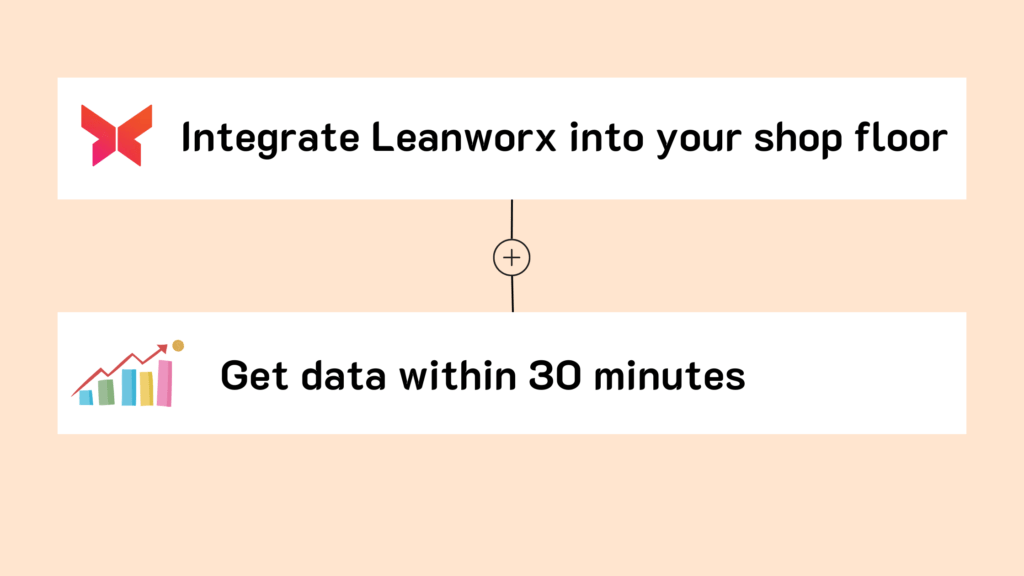Can Machine Monitoring Software Improve Work Ethics?
- Mar 19, 2024
Category : Machine Monitoring system

Dasarathi G V
Director in Leanworx
Dasarathi has extensive experience in CNC programming, tooling, and managing shop floors. His expertise extends to the architecture, testing, and support of CAD/CAM, DNC, and Industry 4.0 systems.
- Downtime due to work ethics issues can account for a surprisingly large amount of downtime.
- Late starting and early stoppage in shifts, extended meal breaks, high downtime in night shifts, etc.
- Total downtime for this can be 10 – 25% of the available time.
- This is low hanging fruit that requires very little time to pluck, and no extra investment in equipment and processes.
- It can be easily eliminated by the use of machine monitoring software, in just 2 weeks.
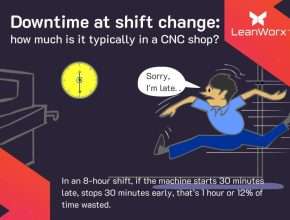
Leanworx’s machine shop monitoring software automatically detects machine downtime durations. Productivity monitoring is done continuously, and downtimes are automatically recorded. Machine downtime reasons can be recorded automatically or via devices that are part of the downtime monitoring system. There are a variety of reports and alerts that help you reduce the waste.
The machine productivity monitoring software shows reports like machine downtime details (the start and end time, duration and reason) of individual downtimes, machine downtime analysis report as Pareto and Pie charts, downtimes at shift change, and machine downtime trends over time – day-wise,a down week-wise, month-wise, etc. It sends alerts on the mobile phone or email to shop supervisors and managers if there an abnormal downtime, or if there is a downtime due to a specific reason. It escalates the alerts to higher level decision makers if a downtime is not fixed.
Fixing downtimes due to poor work ethics becomes easy if you have machine monitoring software with all these features. You can do machine downtime analysis regularly, and eliminate downtimes caused by work ethics issues:
Here are some real life case studies, benefits that users saw in just 1 to 2 weeks after installing our Leanworx for monitoring machine utilization.
Downtime at shift change - how does machine shop monitoring software fix this ?
Let’s say you work 3 shifts of 8 hours each, and the operator starts production 30 minutes late at the start of each shift and stops 30 minutes early at the end of each shift. This means you lose 3 hours every day. If your planned production time is 22 hours in a day, you are losing 13 % of the available capacity. This is very common. The last start and early stoppage tend to be more in the second and third shifts. People may clock in at the correct times at your plant gate, but take their time starting production. Likewise, they may stop production much earlier but clock out at the correct time.
Leanworx machine shop monitoring software keeps track of when the machine is switched on or off, when a part cycle is started and ended, whether a machine is running in auto cycle or manual, etc. It has has a special report that shows downtime at shift change. You can just print this report every day for all machines and put it up on the shop floor notice board. So everyone knows who the slackers are. Once they start doing this, the downtime at shift change reduces to almost zero.
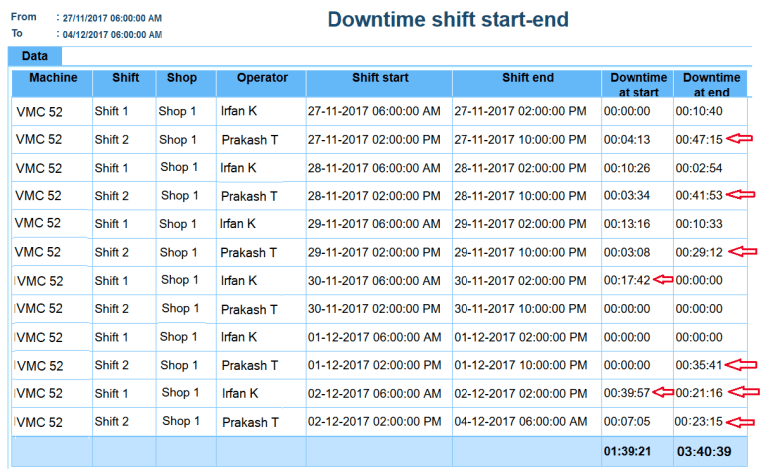
Extended break times - cut to zero
Just extending breaks by 15 minutes in each shift can cause of downtime of 3%. That’s a capacity reduction of 3%. A firm making hydraulic parts on CNC machines did a quiet installation of Leanworx and started real time production tracking. They noticed that their breaks totaling 45 minutes per shift typically extended by 30 minutes in every shift, which meant a 6 % loss in a day. Leanworx was made public after a week, and the 6 % loss reduced to almost 0 % in just a week after this, when people knew that they were being observed.
Leanworx knows the start and end times of each break, and can detect any machine downtime beyond the break. If the machine is idle beyond a break, there are various ways in which this can be observed:
1. Dashboard shows the machine is idle.
2. Andon board shows the machine is idle.
3. It reflects in the downtime details report, downtime analysis report, and OEE reports.
The shop supervisor, manager, etc. get an alert on their mobile phone if the downtime is more than a pre-specified duration.
Downtime in night shift - fixed by machine utilization software
In a firm making aerospace parts, machines work 3 shifts of 8 hours each – 6 AM to 2 PM, 2 PM to 10 PM, and 10 PM to 6 AM. The machines are expensive CNC machining centers and lathes. In the 3rd shift, about one-third of the machines were found to be producing NO parts in the second half of the night shift. The operators were presumably sleeping, because there were no supervisors in the night shift. This means the machines were idle 18 % of the time out of a possible 22 working hours. That is an enormous loss of available time. After a week of observation, the shop Manager started printing the hourly production report every day, for all machines, and putting the reports up on the shop notice board. The night shift production rose to almost the same as the 1st and 2nd shifts immediately.
Here is the Leanworx report that showed the production in the night shift. The report shows that in the second shift there is a part being produced every hour. Same in the first half of the 3rd shift. In the second half of the 3rd shift, however, there are zero parts in each hour. These zero-production hours are automatically highlighted in the report of the machine utilization software.
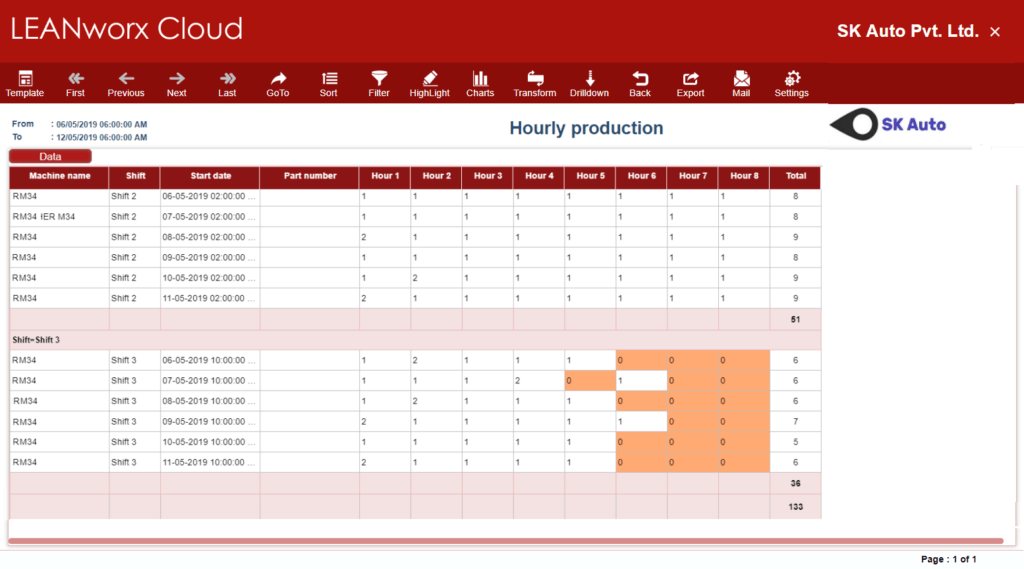
Misuse of feed rate override on CNC machines

Feedrate override misuse is typically done to accelerate parts production to make up for downtime cause by other work ethics issues. This can result in reduced tool life and poor parts quality because of poor surface finish in finishing operations. In a job shop making parts for off-road vehicles, Leanworx’s productivity monitoring software showed misuse of the feed rate override (FRO) on CNC turning centers and machining centers in the night shift. The FRO was set to more than 100 %, the scheduled quantity was done in less time, and the machine was idle for the last hour or two. Although the schedule was met, the surface finish was poor and tool life was reduced. Again, on our advice the shop Manager just pinned the daily print outs of hourly production on the notice board. The problem vanished on its own in a couple of days.
Cooked up production quantity - fixed by monitoring software
Production quantities are often reported wrongly to cover up inefficiencies, resulting in great harm to JIT deliveries, in higher inventories and in improper decision making.
In Leanworx, production quantity is tracked automatically from the machine by the real time production monitoring system, and available as a variety of reports: hourly production, shift-wise and day-wise production, details of individual cycle times, planned vs. Actual production, production quantity trends. Production supervisors and managers get an alert on their mob ile phone or email when there is a target shortfall in a shift. Andon boards in individual sections of shop floors show operators the current production and target in the shift.
Example: In a firm mass producing automobile engine parts, Leanworx productivity monitoring software is installed in their production lines. The production quantity on each machine used to be recorded manually by operators in registers, and reported to supervisors at the end of every shift. This was then entered in the ERP system. The day after Leanworx was installed, a 10 % difference was noticed between the production quantity entered by operators and the quantity recorded by Leanworx. This happened every day.
Operator-recorded production quantities in the first and second shift were lower than actual, while in the third shift they were higher than actual. The manager checked the machine downtime details and machine downtime analysis reports in Leanworx, and found that the downtime was higher in the third shift, so production was lower. The operators were over-reporting the day shift numbers to compensate for low production in the night shift. The problem with this was that the numbers were also being entered into the ERP system and then used generating invoices and shipping documents as part of the JIT despatch system. What is the point of a JIT system that is dependent on false numbers ?
Production quantity is tracked automatically from the machine, and available as a variety of reports:
– Hourly production quantity
– Shift-wise and day-wise production quantity
– Details of individual cycle times
– Planned vs. Actual production
– Production quantity trends.
Production supervisors and managers get an alert on their mobile phone or email when there is a target shortfall in a shift. Andon boards in individual sections of shop floors show the current production and target in the shift.
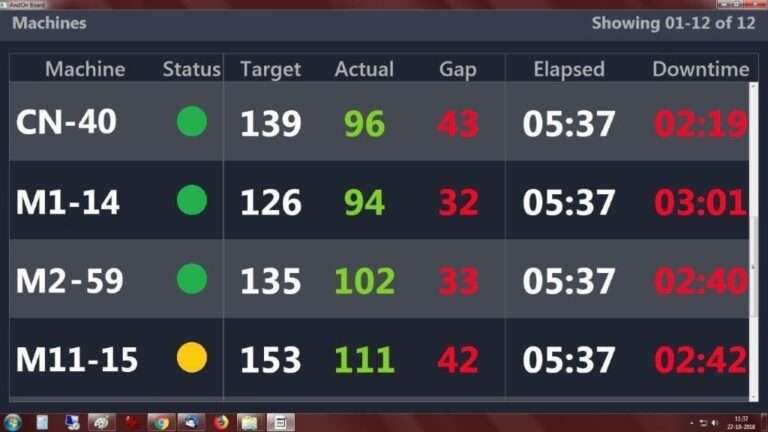
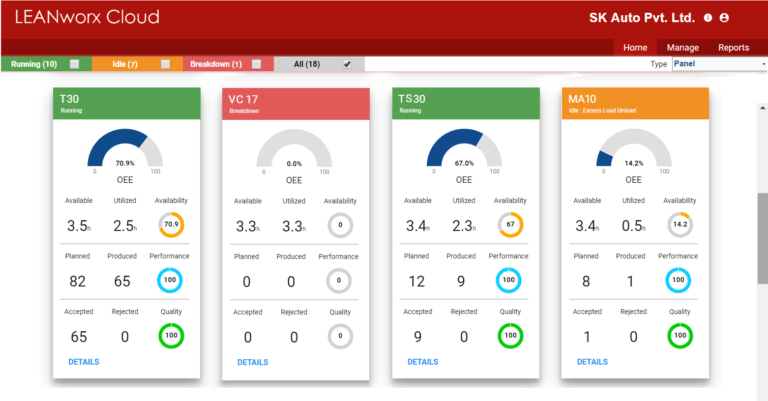
In a lot of shops, just downtimes at shift changes and extended break times can account for up to 1.5 hours in each 8-hour shift, which is an astounding 18 % of available time. If you also have night time sleeping, you can easily hit 30 % downtime because of poor work ethics. An Industry 4.0 based real time machine monitoring software can easily put a stop to this. All these downtimes reduce to almost zero in just 2 weeks after installing the machine monitoring software.
Etc
Jalebi and Imarti (alias Jangiri) – what’s the difference ?
There is a cousin of the Jalebi, called Imarti in the North, and Jangiri in the South. It looks similar, but actually has a bunch of differences. The Jalebi is made of maida (refined wheat flour), while theJangiri is made of Urad dal (black lentil). The Jalebi is flat, while the Jangiri is about twice as tall. The Jalebi is crunchy, while the Jangri is soft. The Jalebi originated in Persia, while the Jangiri originated in North India. The Jalebi is fermented with yoghurt overnight, while the Jangri requires no fermentation. Imarat means ‘building’ in Urdu. The Imarti is built in layers, and I wonder if it got its name because of this ?

The Jangiri is thought to have got its name from the Mughal emperor Jahangir (1569 – 1627), because it was his favourite sweet. Jahangir’s father was Akbar, and his son was Shah Jahan, who built the Taj Mahal. Jahangir is also the Salim of the famous love story Salim-Anarkali (on which the movie Mughal-e-Azam was based). As a prince his name was Salim, and Anarkali was a court dancer he fell in love with. His Dad of course forbade the relationship because Anarkali was not of royal blood and a courtesan to boot. This actually led to a war between the two, which the son lost, etc., and Salim finally had to quit Anarkali. Being a ‘never give up’ guy, he went on to marry 20 women after he became king. If you think 20 wives is a bit much, his Dad Akbar had 35 !


Salim was renamed Jahangir when he ascended the throne. In Persian and Urdu, Jahangir means ‘conqueror of the world’. Jahan means World, and ‘gir’ is the the root of the Persian verb gereftan, which means to seize, or grab. I guess it is also the root of the Urdu words giraftaar (to seize, or imprison) and girebaan (the neck of a shirt).
Jahangir was the father of Shah Jahan (which means ‘king of the world’), who built the Taj Mahal in memory of his (favourite, he had 5) wife, Mumtaz Mahal.
What is this non-technical writing doing in a technical blog ?
Here’s the explanation.
Increase your profits automatically. Use Leanworx to get accurate and instant data 24/7.
